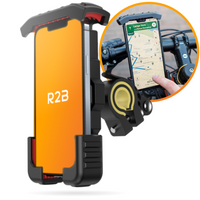No Products in the Cart

How does an anti-freeze blanket work for your car?
Time to read 4 min
Time to read 4 min
In the winter months, cold mornings are often synonymous with frozen car windows and hard frozen surfaces. An anti-freeze blanket for the car offers a simple and effective solution for this. These blankets protect your windshield and other surfaces of your car from freezing, saving you time and effort in the morning. In this article, we explain how an anti-freeze blanket works, how to best use it, and what benefits it offers.
An anti-freeze blanket, also known as a frost protection blanket, is a special blanket that you place over the windshield of your car to protect it from frost and snow. The blanket prevents ice from forming on your windows, so you don't have to scrape the car before you drive away. This saves time, energy and reduces wear and tear on the windows.
An anti-freeze blanket works by creating an insulating layer between the window and the outside air. This insulation helps to retain the heat from the glass and keeps the cold air out, which significantly reduces the formation of ice. Materials such as polyester or other synthetic fibers are often popular because of their insulating properties and durability. Many blankets also have a water-repellent coating to keep snow and moisture out.
An anti-freeze blanket for your car is more than just a convenience; it offers several benefits for both the safety and the lifespan of your vehicle.
With an anti-freeze blanket, you no longer have to scrape your windows or warm up your car to defrost them. Simply remove the blanket and you’re good to go. This is especially handy when you’re in a hurry in the morning.
Every time you have to scrape your windows, you run the risk of scratching the glass. This can affect the clarity of the windows in the long run. An anti-freeze blanket protects the glass, which means you reduce wear and tear and extend the life of your windows.
With a clear, ice-free window you have an immediate better view, which increases safety. Instead of limited visibility through half-transparent frozen windows, with an anti-freeze blanket you can drive immediately clear and without obstacles.
Instead of idling to defrost the windows, which uses fuel and produces harmful emissions, an anti-freeze blanket ensures you can get going right away. This not only saves fuel, but also reduces greenhouse gas emissions.
Using an anti-freeze blanket is easy and requires little time. Follow the steps below for efficient protection against frost:
Place the anti-freeze blanket tightly over the windshield. Make sure the entire window is covered, without gaps where cold air or moisture can penetrate.
Many anti-freeze blankets have straps, hooks or magnets that help keep the blanket firmly in place. Secure these parts to the sides or under the hood so that the blanket does not blow away in the wind.
When you are ready to leave, simply unzip the blanket and fold it. It may be helpful to dry the blanket before storing it, especially if it has become damp from snow or rain.
There are different types of anti-freeze blankets available, each with their own advantages depending on use and weather conditions.
Standard blankets are usually made of sturdy material that is resistant to cold and moisture. They are relatively easy to install and offer good protection against light frost and snow.
These blankets have multiple layers, including a thermal insulation layer that provides extra protection in extreme cold conditions. These blankets are ideal for riders who live in areas with harsh winters and heavy snowfall.
Some blankets have a reflective outer layer that can reflect sunlight. This not only helps prevent frost, but can also help regulate the temperature of the window on sunny days. This type of blanket is useful for use in changing weather conditions.
Not all anti-freeze blankets are the same. Here are some factors to consider when making your choice:
Choose a blanket that fits the dimensions of your car and windshield. A blanket that is too small will not provide enough coverage, while a blanket that is too large may be more difficult to attach.
Choose a blanket made of durable, water-resistant material that can withstand winter conditions. Synthetic fabrics such as polyester provide good insulation and are often water-resistant.
Check if the blanket has good fastening options, such as straps, hooks or magnets. This prevents the blanket from coming loose due to wind or rain.
An anti-freeze blanket that folds compactly offers convenience in storage. Some blankets come with a handy storage bag that prevents the blanket from getting wet or taking up space in the car.
Yes, an anti-freeze blanket can also keep snow out. It prevents snow from falling directly onto your windows, making it easy to remove.
Yes, a good anti-freeze blanket is designed to be used every day during the winter months. However, check it regularly for wear and tear to ensure it remains effective.
In theory you can make a blanket yourself using insulating material, but a specially designed anti-freeze blanket offers better protection and durability.

